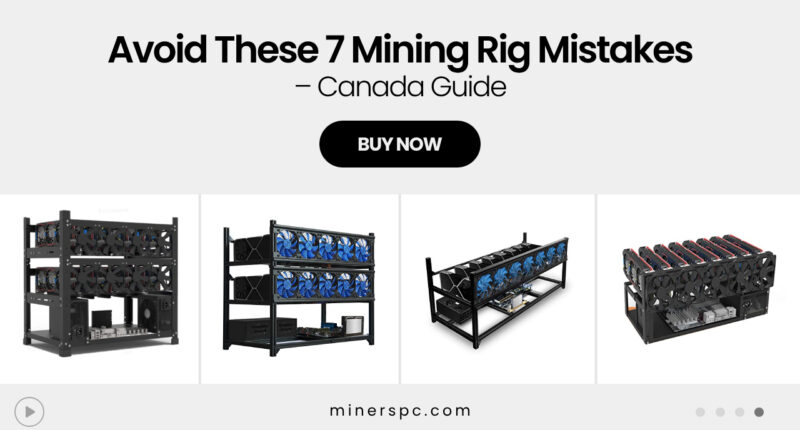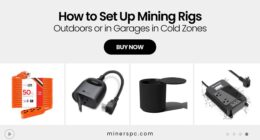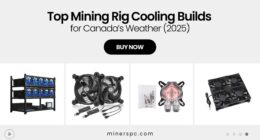For many Canadians diving into cryptocurrency mining, the DIY route offers a sense of control and long-term value. But building your own mining rig isn’t just plug-and-play. It takes planning, technical know-how, and a fair bit of trial and error—unless you learn from those who’ve already walked the path.
Whether you’re mining in a heated basement in Toronto or a chilly garage in Alberta, avoiding common mistakes can save you from burnt-out GPUs, unstable power issues, or wasted investments. Below, we break down the top seven mistakes Canadian miners make—and more importantly, how to avoid them like a pro.
1. Skipping the Right Mining Frame Setup
A mining rig is only as stable and efficient as the frame it sits on. Far too many beginners slap components together without considering airflow, stackability, or component spacing. In Canada, where temperature swings and dust levels vary by season, this can be a critical error.
Solution: Choose a mining frame designed for airflow and scalability. Open air frames like the Kingwin Crypto Mining Rig Case or the Open Mining Rig Frame with 6 GPU Slots are ideal. They’re lightweight, stackable, and allow for easy cooling—especially in colder provinces.
2. Underestimating Power Supply Needs
Power miscalculations are the silent killer of mining rigs. Some miners try to run multiple GPUs off a single underpowered PSU, which leads to thermal throttling, resets, or worse—component damage.
Solution: Always calculate the total wattage your rig will draw at full load (not idle) and add a 20–30% buffer. If you’re running dual PSUs, tools like The North Miner Power Board Adapter make syncing them seamless and safe.
3. Neglecting Proper Cooling – Even in Cold Climates
Yes, Canada is cold. But that doesn’t mean your mining rig will stay cool—especially indoors. GPUs can still overheat in winter if heat builds up around poorly ventilated rigs. Over time, this leads to thermal degradation or reduced hash rates.
Solution: Use a frame with room for multiple fans. Options like the ZLP Veddha 14 GPU Frame with 12 Fans give you both high-density setup capacity and serious airflow. Even in cooler garages, strategic ventilation is a must.
4. Buying the Wrong Rig for the Wrong Coin
Mining isn’t one-size-fits-all. What works for Bitcoin may not be profitable for Ethereum Classic or Ravencoin. Some Canadian hobbyists invest heavily in ASICs without researching whether their preferred coin is ASIC-resistant.
Solution: Match the rig to the algorithm. The QIO TECH Bitmain Antminer S19 is a beast for SHA-256 (Bitcoin), while the Bitaxe Gamma 601 ASIC Miner is excellent for home-scale mining experiments. If you’re leaning GPU, keep it modular with open frames and diversify your coin choices.
5. Improper Cable Management & Poor Safety Practices
Loose cables aren’t just messy—they’re dangerous. They restrict airflow, increase the risk of shorts, and make troubleshooting a nightmare. In areas with dry winters (hello, Manitoba), static discharge from poor grounding is a real threat.
Solution: Use zip ties, cable combs, and always keep power cables clear of fan intakes. Better still, build your rig on a frame like the Mining Rig Frame for 12 GPU with Steel Build, which has clearly defined zones for PSUs, motherboards, and cabling.
6. Ignoring Noise and Heat Output Indoors
Many Canadian miners start in their living room or basement—until the rig starts sounding like a snowblower and heating the whole floor. High-performance rigs, especially multi-GPU or ASICs, aren’t quiet or cool.
Solution: Choose quieter, lower-power options like the Bitcoins Miner USB Lucky Miner V2 for casual mining or experimentation. For larger setups, relocate rigs to well-ventilated sheds or garages, especially during colder months.
7. Overcomplicating the Build on Day One
It’s tempting to go big right out the gate—stack 8 GPUs, dual power supplies, overclock everything. But complexity introduces more points of failure. If you’re new to mining, start lean.
Solution: Use a reliable mid-sized frame like the 8 GPU Open Air Steel Frame that balances expansion potential with simplicity. Learn the ropes on one or two GPUs, get familiar with BIOS settings, thermals, and mining software before scaling.
Expert Tip from the North
From our experience working with miners in Saskatchewan and B.C., we’ve found that building your rig during the fall is the sweet spot. Why? You’ll have time to stress-test before deep winter hits—and you can take advantage of cooler ambient temps without fighting dust, pollen, or summer humidity.
Final Thoughts
Building your own mining rig in Canada can be incredibly rewarding—but only if you avoid the common pitfalls that drain your ROI. From picking the right frame to powering it correctly and cooling it smartly, every decision matters. By planning ahead and choosing quality components tailored for Canadian conditions, you’ll ensure long-term uptime, stability, and profits.
Looking for the perfect pick? Explore the top recommendations below while they’re still available – these won’t stay in stock for long.

















![Best Prebuilt PCs in Canada for Work, School & Gaming [2025 Guide]](https://www.minerspc.com/wp-content/uploads/2025/07/best-prebuilt-pcs-in-canada-for-work-school-gaming-2025-guide-260x140.jpg)


